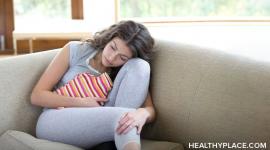Depression in Women: Understanding Female Depression

Women experience depression twice as often as men. According to the National Mental Health Association:
- Approximately 12 million women in the United States experience clinical depression each year.
- About one in every eight women can expect to develop clinical depression during their lifetime.
The diagnostic criteria for depression in women is the same as for men, but women with depression more frequently experience guilt, anxiety, increased appetite and sleep, weight gain and comorbid eating disorders.
Over the course of a lifetime, depression occurs in approximately 20% of women compared with 12% of men. Although the exact reason for this difference is not known, biological, life cycle and psychosocial factors may relate to the higher rate of depression in women.
Women and Depression – Effect of Hormones
Hormones and depression in women may also be linked. Researchers have shown hormones directly effects the brain chemistry controlling emotions and mood. For example, depression in women is particularly common after giving birth, when hormonal and physical changes, along with the new responsibility of caring for a newborn, can be overwhelming. About 10%-15% of women will develop postpartum depression, a serious condition that requires active treatment.
Some women may also be susceptible to a severe form of premenstrual syndrome (PMS) called premenstrual dysphoric disorder (PMDD). PMDD affects mood and is thought to occur due to the hormonal changes that happen around ovulation and before menstruation begins. The transition into menopause also seems to affect hormones and depression in women.
Risk Factors for Depression in Women
- Family or personal history of mood disorders
- Loss of a parent before the age of ten
- History of childhood physical or sexual abuse
- Use of an oral contraceptive, especially one with a high progesterone content
- Use of gonadotropin stimulants as part of infertility treatment
- Persistent psychosocial stressors (e.g., loss of job)
- Loss of social support system or the threat of such a loss
Diagnosis of Depression in Women
The diagnostic criteria for major depression, as established in the latest version of the Diagnostic and Statistical Manual of Mental Disorders (DSM-IV-TR), are the same for women and men (Table below). The diagnosis of depression requires the presence of depressed mood or diminished pleasure (anhedonia), plus four other symptoms for at least two weeks.1
Diagnostic Criteria for Major Depression
- Depressed mood
- Diminished interest or loss of pleasure in almost all activities (anhedonia)
- Significant weight change or appetite disturbance
- Sleep disturbance (insomnia or hypersomnia)
- Psychomotor agitation or retardation
- Fatigue or loss of energy
- Feelings of worthlessness
- Diminished ability to think or concentrate; indecisiveness
- Recurrent thoughts of death, suicidal
- A pattern of long-standing interpersonal rejection ideation, suicide attempt, or specific plan for suicide
Additional depression diagnosis criteria are as follows:
- The symptoms must cause significant distress or impairment of functioning in social, occupational, or other important areas.
- Depression should not have been precipitated by the direct action of a substance or a general medical condition.
- Symptoms should not meet criteria for a mixed episode (ie, for both manic and depressive episode).
- Symptoms are not better accounted for by bereavement (ie, the symptoms persist for longer than 2 months or are characterized by marked functional impairment, morbid preoccupation with worthlessness, suicidal ideation, psychotic symptoms, or psychomotor retardation).
- A major depressive episode should not be superimposed on schizophrenia, schizophreniform disorder, delusional disorder, or a psychotic disorder not otherwise specified (NOS).
American Psychiatric Association. Diagnostic and Statistical Manual of Mental Disorder, Text Revision. 4th Edition. Washington, DC: American Psychiatric Association; 2000.
The presentation and course of depression in women is sometimes different to that of men (Table below). Seasonal depression is more common in women as are the symptoms of atypical depression (i.e., hypersomnia, hyperphagia, carbohydrate craving, weight gain, a heavy feeling in the arms and legs, evening mood exacerbations and initial insomnia). In addition, women more frequently have symptoms of anxiety, panic, phobia and eating disorders. Women also have a higher incidence of hypothyroidism, a condition that is one of the causes of depression in women. Finally, exogenous and endogenous gonadal steroids may have a greater impact on depression in women than depression in men.
Depression in Women vs. Depression in Men
| Women vs. Men | |
| Lifetime prevalence | 20% of women vs. 12% of men |
| 20% of women vs. 12% of men | Earlier in women |
| Seasonal affect on mood | Greater in women |
| Association with stressful social events | More common in women |
| Atypical symptoms (such as oversleeping or overeating) | More common in women |
| Feelings of guilt and anxiety | More common in women |
| Suicidality | Women attempt suicide more frequently while men successfully commit suicide more often. |
| Association with eating disorders | More common in women |
| Association with substance use | Less common in women |
| Association with thyroid disease, migraines | More common in women |
| Association of antisocial, narcissistic and obsessive-compulsive personalities | Less common in women |
| Effect of exogenous and endogenous gonadal steroids on mood | Effect of exogenous and endogenous gonadal steroids on mood |
Depression in Women and Suicide
Depression is a significant risk factor for suicidal behavior in both sexes. Depressed women more often attempt suicide, whereas men more often complete suicide. In fact, the male-to-female ratio for completed suicides is greater than four-to-one, possibly because women with depression frequently choose less lethal methods like poisoning. Significant risk factors for suicide by depressed women are listed below. (in-depth information on suicide, suicide hotline phone numbers 1-800-273-8255)
High-Risk Factors for Suicidal Behavior in Women
Risk for suicide attempts2
- Age less than 35 years
- Threatened loss of intimate relationship; separation or divorce
- Current psychosocial stressors (e.g., recent loss of job)
- Substance abuse
- Diagnosis of a mental illness like depression or a personality disorder
- History of physical or sexual abuse
- Incarceration
- Exposure to suicidal behavior of others
- Family history of suicide
- Severe anxiety and/or panic attacks
- Insomnia
- Recent diagnosis of a life-threatening illness
Risk for completed suicide3
- Severe clinical depression, especially with psychosis
- Substance abuse
- History of suicide attempts
- Current active suicidal ideation or plan
- One or more active, chronic, often deteriorating medical illnesses
- Feelings of hopelessness
- Severe anxiety or panic especially if mixed with depression
- Access to a firearm
During the initial visit, every depressed woman should be screened for suicidal thoughts, intent and plan, as well as the availability and lethality of a method for committing suicide. This screening may provide an opportunity for lifesaving intervention for women in depression.
Poisoning is the method employed in 70% of all suicide attempts by women; so initially, women with depression may only be prescribed one week of antidepressants at a time. When treating women and depression it is also important to enlist at least one of the patient's family members or friends to monitor intake of the prescribed antidepressant so the patient does not hoard the medication for use in a suicide attempt.
Hospitalization is necessary for women with severe depression, psychosis, substance abuse, severe hopelessness or limited social support. Women with depression should also be hospitalized if they articulate or display a strong urge to act on suicidal thoughts or if they have a specific suicide plan that is likely to be successful.
Sources:
- Blehar MC, Oren DA. Gender differences in depression. Medscape Women's Health, 1997;2:3. Revised from: Women's increased vulnerability to mood disorders: Integrating psychobiology and epidemiology. Depression, 1995;3:3-12.
- Rubinow DR, Schmidt PJ, Roca CA. Estrogen-serotonin interactions: implications for affective regulation. Biological Psychiatry, 1998; 44(9): 839-850.
- NIMH, Depression publication. Last updated April 2008.
(Get trusted, comprehensive depression treatment information)
See Also:
APA Reference
Tracy, N.
(2022, January 3). Depression in Women: Understanding Female Depression, HealthyPlace. Retrieved
on 2026, January 21 from https://www.healthyplace.com/depression/women/depression-in-women-understanding-female-depression



